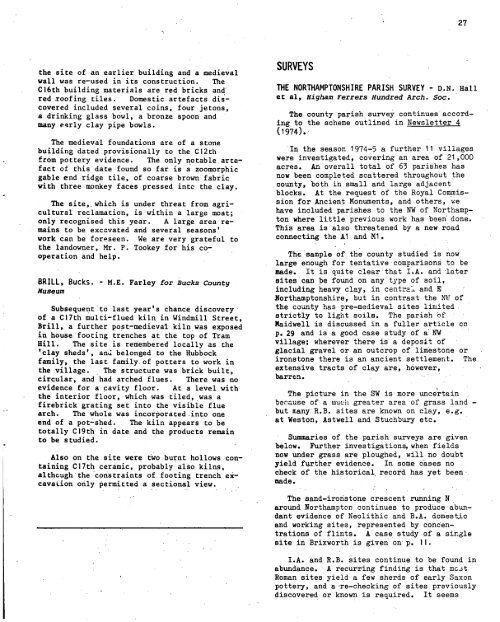Untitled - Council for British Archaeology
Untitled - Council for British Archaeology
Untitled - Council for British Archaeology
You also want an ePaper? Increase the reach of your titles
YUMPU automatically turns print PDFs into web optimized ePapers that Google loves.
27<br />
the site of an earlier building and a medieval<br />
wall was re-used in its construction. The<br />
Cl6th building materials are red bricks and<br />
red xoofing tiles. Domestic artefacts discovered<br />
included several coins, four jetons,<br />
a drinking glass bowl, a bronze spoon and<br />
many early clay pipe bowls.<br />
The medieval foundations are of a stone<br />
building dated provisionally to the Cl2th<br />
from pottery evidence. The only notable artefact<br />
of this date found so far is a zoomorphic<br />
gable end ridge tile, of coarse brown fabric<br />
with three monkey faces pressed intc the clay.<br />
The site, which is under threat from agricultural<br />
reclamation, is within a large moat;<br />
only recognised this year. A large area remains<br />
to be excavated and several seasons'<br />
work can be <strong>for</strong>Pseen. We are very grateful to<br />
the landowner, Mr. P. Tookey <strong>for</strong> his cooperation<br />
and help.<br />
BRILL, Bucks. - M.E. Farley <strong>for</strong> Bucks County<br />
Museum<br />
Subsequent to last year's chance discovery<br />
of a Cl7th multi-flued kiln in Windmill Street,<br />
Brill, a further post-medieval kiln was exposed<br />
in house footing trenches at the top of Tram<br />
Hill. The site is remembered locally as the<br />
'clay sheds', and belonged to the Hubbock<br />
family, the last family of potters to work in<br />
the village. The structure was brick built,<br />
circular, and had arched flues. There was no<br />
evidence <strong>for</strong> a cavity floor. At a level with<br />
the interior floor, which was tiled, was a<br />
firebrick grating set into the visible flue<br />
arch. The whole was incorporated into one<br />
end of a pot-shed. The kiln appears to be<br />
totally Cl9th in date and the products remain<br />
to be studied.<br />
Also on the site were ewo burnt hollows containing<br />
Cl7th ceramic, probably also kilns,<br />
although the constraints of footing trench excavation<br />
only permitted a sectional view.<br />
SURVEYS<br />
THE NORTHAMPTONSHIRE PARISH SURVEY - D.N. Hall<br />
et al, Higham Ferrers Hundred Arch. Soc.<br />
The county parish survey continues according<br />
to the scheme outlined in Newsletter 4<br />
(1974).<br />
'In the season 1974-5 a further 11 villages<br />
were investigated, covering an area of 21,000<br />
acres. An overall total of 63 parishes has<br />
now been completed scattered throughout the<br />
county, both in small and large adjacent<br />
blocks. At the request of the Royal Commission<br />
<strong>for</strong> Ancient Monuments, and others, we<br />
have included parishes to the NI of Northampton<br />
where little previous work has been' done.<br />
This area is also threatened by a new road<br />
connecting the Al and Ml.<br />
The sample of the county studied is now<br />
large enough <strong>for</strong> tentative comparisonS to be<br />
made. It is'quite clear-that I.A. and later<br />
sites can be found on any type of soil,<br />
including heavy clay, in central and E<br />
Northamptonshire, but in contrast the NW of<br />
the county has pre-medieval sites limited<br />
strictly to light soils. The parish 'of<br />
Maidwell is discussed in a fuller article en<br />
p.29 and is a good case study of a'NW<br />
village; wherever there is a deposit of<br />
glacial gravel or an outcrop of limestone or<br />
ironstone there is an ancient settlement. The<br />
extensive tracts of clay are, hOwever,<br />
barren.<br />
The picture in the SW is more uncértain<br />
because of a much greater area 'of grass land -<br />
but many R.B. sites are known on clay, e.g.<br />
at Weston, Astwell and Stuchbury etc.<br />
Summaries of the parish surveys are given,<br />
below. Further investigations, when fields<br />
now under grass are ploughed, will no doubt<br />
yield further evidence. In some Cases no<br />
check Of the historical, record has yet beenmade.<br />
The sand-ironstone crescent running N<br />
around Northampton continues to produce abundant<br />
evidence of Neolithic and B.A. domestic<br />
and working sites, represented by concentrations<br />
of flints. A case study of a single<br />
site in Brixworth is given on p. 11.<br />
I.A. and R.B. sites continue to be found in<br />
abundance. A recurring finding is that mc..it<br />
Roman sites yield a few sherds of early Saxon<br />
pottery, and a ,re-checking of sites previously<br />
discovered or known is required. It seems

















